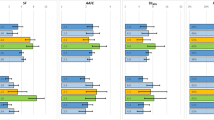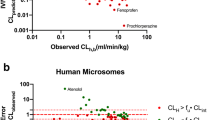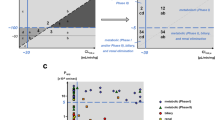Abstract
In vitro-in vivo extrapolation ((IVIVE) and empirical scaling factors (SF) of human intrinsic clearance (CLint) were developed using one of the largest dataset of 455 compounds with data from human liver microsomes (HLM) and human hepatocytes (HHEP). For extended clearance classification system (ECCS) class 2/4 compounds, linear SFs (SFlin) are approximately 1, suggesting enzyme activities in HLM and HHEP are similar to those in vivo under physiological conditions. For ECCS class 1A/1B compounds, a unified set of SFs was developed for CLint. These SFs contain both SFlin and an exponential SF (SFβ) of fraction unbound in plasma (fu,p). The unified SFs for class 1A/1B eliminate the need to identify the transporters involved prior to clearance prediction. The underlying mechanisms of these SFs are not entirely clear at this point, but they serve practical purposes to reduce biases and increase prediction accuracy. Similar SFs have also been developed for preclinical species. For HLM-HHEP disconnect (HLM > HHEP) ECCS class 2/4 compounds that are mainly metabolized by cytochrome P450s/FMO, HLM significantly overpredicted in vivo CLint, while HHEP slightly underpredicted and geometric mean of HLM and HHEP slightly overpredicted in vivo CLint. This observation is different than in rats, where rat liver microsomal CLint correlates well with in vivo CLint for compounds demonstrating permeability-limited metabolism. The good CLint IVIVE developed using HLM and HHEP helps build confidence for prospective predictions of human clearance and supports the continued utilization of these assays to guide structure–activity relationships to improve metabolic stability.
Graphical Abstract







Similar content being viewed by others
Data Availability
All data generated or analysed during this study are included in this published article.
Abbreviations
- ADME:
-
Absorption, distribution, metabolism, and excretion
- AFE:
-
Average fold error
- ALQ:
-
Above the limit of quantification
- BLQ:
-
Below the limit of quantification
- CLh :
-
Hepatic clearance
- CLint :
-
Intrinsic clearance
- CO2 :
-
Carbon dioxide
- CYP:
-
Cytochrome P450
- DDI:
-
Drug-drug interaction
- DI90% :
-
Total deviation index (a measure of the fold range that captures 90% of prediction errors)
- ECCS:
-
Extended clearance classification system
- ELogD:
-
Chromatographic LogD
- FMO:
-
Flavin-containing monooxygenase
- f u,lm :
-
Fraction unbound in liver microsomes
- f u,p :
-
Fraction unbound in plasma
- HEK-293:
-
Immortalized human embryonic kidney cell line
- HEP:
-
Hepatocytes
- HHEP:
-
Human hepatocytes
- HLM:
-
Human liver microsomes
- HTD 96:
-
96-Well high throughput equilibrium dialysis device
- IV :
-
Intravenous
- IVIVE :
-
In vitro-in vivo Extrapolation
- k w :
-
Chromatographic capacity factor in aqueous
- LC–MS/MS:
-
Liquid chromatography with tandem mass spectrometry
- LM :
-
Liver microsomes
- logD7.4 :
-
Log10 of distribution coefficient between octanol and pH 7.4 buffer
- MDCK:
-
Madin-Darby canine kidney cell line
- MDCK-LE:
-
Low efflux MDCK cell line (i.e., RRCK)
- MgCl2 :
-
Magnesium chloride
- NADPH:
-
Reduced nicotinamide adenine dinucleotide phosphate
- NHP:
-
Non-human primate
- OAT:
-
Organic anion transporter
- OATP:
-
Organic anion transporting polypeptides
- P app :
-
Apparent permeability
- PBPK:
-
Physiologically based pharmacokinetic modeling
- PBS:
-
Phosphate-buffered saline
- PK:
-
Pharmacokinetics
- pKa :
-
Negative log10 of acid dissociation constant
- Rbp :
-
Blood-to-plasma ratio
- rpm:
-
Revolutions per minute
- RRCK:
-
Ralph and Russ canine kidney cell line (i.e., MDCK-LE)
- SAR:
-
Structure-activity relationships
- SF:
-
Scaling factor
- SFβ :
-
Exponential scaling factor
- SFlin :
-
Linear scaling factor
- SFLogD:
-
Shake-flask LogD
- UV:
-
Ultraviolet
References
Smith DA, Beaumont K, Maurer TS, Di L. Clearance in drug design. J Med Chem. 2019;62(5):2245–55. https://doi.org/10.1021/acs.jmedchem.8b01263.
Smith DA, Beaumont K, Maurer TS, Di L. Relevance of half-life in drug design. J Med Chem. 2018;61(10):4273–82. https://doi.org/10.1021/acs.jmedchem.7b00969.
Smith DA, Beaumont K, Maurer TS, Di L. Volume of distribution in drug design. J Med Chem. 2015;58(15):5691–8. https://doi.org/10.1021/acs.jmedchem.5b00201.
Benet LZ, Zia-Amirhosseini P. Basic principles of pharmacokinetics. Toxicol Pathol. 1995;23(2):115. https://doi.org/10.1177/019262339502300203.
van de Waterbeemd H, Smith DA, Beaumont K, Walker DK. Property-based design: optimization of drug absorption and pharmacokinetics. J Med Chem. 2001;44(9):1313–33. https://doi.org/10.1021/jm000407e.
Caldwell GW, Masucci JA, Yan Z, Hageman W. Allometric scaling of pharmacokinetic parameters in drug discovery: can human CL, Vss and t1/2 be predicted from in-vivo rat data? Eur J Drug Metab Pharmacokinet. 2004;29(2):133–43. https://doi.org/10.1007/bf03190588.
Huang Q, Riviere JE. The application of allometric scaling principles to predict pharmacokinetic parameters across species. Expert Opin Drug Metab Toxicol. 2014;10(9):1241–53. https://doi.org/10.1517/17425255.2014.934671.
Lin JH. Applications and limitations of interspecies scaling and in vitro extrapolation in pharmacokinetics. Drug Metab Dispos. 1998;26(12):1202–12.
Riede J, Poller B, Umehara K-i, Huwyler J, Camenisch G. New IVIVE method for the prediction of total human clearance and relative elimination pathway contributions from in vitro hepatocyte and microsome data. Eur J Pharm Sci. 2016;86:96–102. https://doi.org/10.1016/j.ejps.2016.02.022.
Obach RS. Prediction of human clearance of twenty-nine drugs from hepatic microsomal intrinsic clearance data: an examination of in vitro half-life approach and nonspecific binding to microsomes. Drug Metab Dispos. 1999;27(11):1350–9.
Hallifax D, Foster JA, Houston JB. Prediction of human metabolic clearance from in vitro systems: retrospective analysis and prospective view. Pharm Res. 2010;27(10):2150–61. https://doi.org/10.1007/s11095-010-0218-3.
Hosea NA, Collard WT, Cole S, Maurer TS, Fang RX, Jones H, et al. Prediction of human pharmacokinetics from preclinical information: comparative accuracy of quantitative prediction approaches. J Clin Pharmacol. 2009;49(5):513–33.
Chen Y, Jin JY, Mukadam S, Malhi V, Kenny JR. Application of IVIVE and PBPK modeling in prospective prediction of clinical pharmacokinetics: strategy and approach during the drug discovery phase with four case studies PROSPECTIVE Simcyp SIMULATION OF CLINICAL PK DATAY. CHEN ET AL. Biopharm Drug Dispos. 2012;33(2):85-98. https://doi.org/10.1002/bdd.1769.
Jones HM, Gardner IB, Watson KJ. Modelling and PBPK simulation in drug discovery. AAPS J. 2009;11(1):155–66. https://doi.org/10.1208/s12248-009-9088-1.
Davies M, Jones RDO, Grime K, Jansson-Lofmark R, Fretland AJ, Winiwarter S, et al. Improving the accuracy of predicted human pharmacokinetics: lessons learned from the AstraZeneca drug pipeline over two decades. Trends Pharmacol Sci. 2020;41(6):390–408. https://doi.org/10.1016/j.tips.2020.03.004.
Di L. The role of drug metabolizing enzymes in clearance. Expert Opin Drug Metab Toxicol. 2014;10(3):379–93. https://doi.org/10.1517/17425255.2014.876006.
Keefer C, Chang G, Carlo A, Novak JJ, Banker M, Carey J, et al. Mechanistic insights on clearance and inhibition discordance between liver microsomes and hepatocytes when clearance in liver microsomes is higher than in hepatocytes. Eur J Pharm Sci. 2020;155:105541. https://doi.org/10.1016/j.ejps.2020.105541.
Di L, Keefer C, Scott DO, Strelevitz TJ, Chang G, Bi Y-A, et al. Mechanistic insights from comparing intrinsic clearance values between human liver microsomes and hepatocytes to guide drug design. Eur J Med Chem. 2012;57:441–8. https://doi.org/10.1016/j.ejmech.2012.06.043.
Di L, Trapa P, Obach RS, Atkinson K, Bi Y-A, Wolford AC, et al. A novel relay method for determining low-clearance values. Drug Metab Dispos. 2012;40(9):1860–5. https://doi.org/10.1124/dmd.112.046425.
Jones RS, Leung C, Chang JH, Brown S, Liu N, Yan Z, et al. Application of empirical scalars to enable early prediction of human hepatic clearance using in vitro-in vivo extrapolation in drug discovery: an evaluation of 173 drugs. Drug Metab Dispos. 2022;50(8):1053–63. https://doi.org/10.1124/dmd.121.000784.
Chan TS, Yu H, Moore A, Khetani SR, Tweedie D. Meeting the challenge of predicting hepatic clearance of compounds slowly metabolized by cytochrome P450 using a novel hepatocyte model. HepatoPac Drug Metab Dispos. 2013;41(12):2024–32. https://doi.org/10.1124/dmd.113.053397.
Francis LJ, Houston JB, Hallifax D. Impact of plasma protein binding in drug clearance prediction: a database analysis of published studies and implications for in vitro-in vivo extrapolation. Drug Metab Dispos. 2021;49(3):188–201. https://doi.org/10.1124/dmd.120.000294.
Poulin P, Hop CECA, Ho Q, Halladay JS, Haddad S, Kenny JR. Comparative assessment of in vitro-in vivo extrapolation methods used for predicting hepatic metabolic clearance of drugs. J Pharm Sci. 2012;101(11):4308–26. https://doi.org/10.1002/jps.23288.
Poulin P, Haddad S. Toward a new paradigm for the efficient in vitro-in vivo extrapolation of metabolic clearance in humans from hepatocyte data. J Pharm Sci. 2013;102(9):3239–51. https://doi.org/10.1002/jps.23502.
Saravanakumar A, Sadighi A, Ryu R, Akhlaghi F. Physicochemical properties, biotransformation, and transport pathways of established and newly approved medications: a systematic review of the top 200 most prescribed drugs vs. the FDA-approved drugs between 2005 and 2016. Clin Pharmacokinet. 2019;58(10):1281–94. https://doi.org/10.1007/s40262-019-00750-8.
Martignoni M, Groothuis GMM, de Kanter R. Species differences between mouse, rat, dog, monkey and human CYP-mediated drug metabolism, inhibition and induction. Expert Opin Drug Metab Toxicol. 2006;2(6):875–94. https://doi.org/10.1517/17425255.2.6.875.
Di L, Feng B, Goosen TC, Lai Y, Steyn SJ, Varma MV, et al. A perspective on the prediction of drug pharmacokinetics and disposition in drug research and development. Drug Metab Dispos. 2013;41(12):1975–93. https://doi.org/10.1124/dmd.113.054031.
Mathew S, Tess D, Burchett W, Chang G, Woody N, Keefer C, et al. Evaluation of prediction accuracy for volume of distribution in rat and human using in vitro, in vivo, PBPK and QSAR methods. J Pharm Sci (Philadelphia, PA, U S). 2021;110(4):1799–823. https://doi.org/10.1016/j.xphs.2020.12.005.
Di L, Artursson P, Lennernas H, Avdeef A, Benet L, Houston B, et al. The critical role of passive permeability in designing successful drugs. ChemMedChem. 2020;15(20):1862–74. https://doi.org/10.1002/cmdc.202000419.
Di L, Rong H, Feng B. Demystifying brain penetration in central nervous system drug discovery. J Med Chem. 2013;56(1):2–12. https://doi.org/10.1021/jm301297f.
Nigade PB, Gundu J, Pai KS, Nemmani KVS, Talwar R. Prediction of volume of distribution in preclinical species and humans: application of simplified physiologically based algorithms. Xenobiotica. 2019;49(5):528–39. https://doi.org/10.1080/00498254.2018.1474399.
Jones RD, Jones HM, Rowland M, Gibson CR, Yates JWT, Chien JY, et al. PhRMA CPCDC initiative on predictive models of human pharmacokinetics, Part 2: Comparative assessment of prediction methods of human volume of distribution. J Pharm Sci. 2011;100(10):4074–89. https://doi.org/10.1002/jps.22553.
Price E, Kalvass JC, DeGoey D, Hosmane B, Doktor S, Desino K. Global analysis of models for predicting human absorption: QSAR, in vitro, and preclinical models. J Med Chem. 2021;64(13):9389–403. https://doi.org/10.1021/acs.jmedchem.1c00669.
Paine SW, Menochet K, Denton R, McGinnity DF, Riley RJ. Prediction of human renal clearance from preclinical species for a diverse set of drugs that exhibit both active secretion and net reabsorption. Drug Metab Dispos. 2011;39(6):1008–13. https://doi.org/10.1124/dmd.110.037267.
Mahmood I. Interspecies scaling of renally secreted drugs. Life Sci. 1998;63(26):2365–71. https://doi.org/10.1016/s0024-3205(98)00525-6.
Jansen K, Pou Casellas C, Groenink L, Wever KE, Masereeuw R. Humans are animals, but are animals human enough A systematic review and meta-analysis on interspecies differences in renal drug clearance. Drug Discovery Today. 2020;25(4):706–17. https://doi.org/10.1016/j.drudis.2020.01.018.
Riley RJ, McGinnity DF, Austin RP. A unified model for predicting human hepatic, metabolic clearance from in vitro intrinsic clearance data in hepatocytes and microsomes. Drug Metab Dispos. 2005;33(9):1304–11.
Tess DA, Ryu S, Di L. In vitro - in vivo extrapolation of hepatic clearance in preclinical species. Pharm Res. 2022;39(7):1615–32. https://doi.org/10.1007/s11095-022-03205-1.
Varma MV, Steyn SJ, Allerton C, El-Kattan AF. Predicting clearance mechanism in drug discovery: extended clearance classification system (ECCS). Pharm Res. 2015;32(12):3785–802. https://doi.org/10.1007/s11095-015-1749-4.
Lombardo F, Berellini G, Scott OR. Trend analysis of a database of intravenous pharmacokinetic parameters in humans for 1352 drug compounds. Drug Metab Dispos. 2018;46(11):1466–77. https://doi.org/10.1124/dmd.118.082966.
Li AP, Lu C, Brent JA, Pham C, Fackett A, Ruegg CE, et al. Cryopreserved human hepatocytes: characterization of drug-metabolizing enzyme activities and applications in higher throughput screening assays for hepatotoxicity, metabolic stability, and drug-drug interaction potential. Chem Biol Interact. 1999;121(1):17–35. https://doi.org/10.1016/s0009-2797(99)00088-5.
Beal SL. Ways to fit a PK model with some data below the quantification limit. J Pharmacokinet Pharmacodyn. 2001;28(5):481–504.
Di L, Whitney-Pickett C, Umland JP, Zhang H, Zhang X, Gebhard DF, et al. Development of a new permeability assay using low-efflux MDCKII cells. J Pharm Sci. 2011;100(11):4974–85.
Novak JJ, Di L, Burchett W. Effects of low temperature on blood-to-plasma ratio measurement. Biopharm Drug Dispos. 2021;42(5):234–41.
Chang G, Woody N, Keefer C. Providing the ‘best’ lipophilicity assessment in a drug discovery environment. ChemRxiv. 2021. https://doi.org/10.26434/chemrxiv.14292485.v1.
Hay T, Jones R, Beaumont K, Kemp M. Modulation of the partition coefficient between octanol and buffer at pH 7.4 and pKa to achieve the optimum balance of blood clearance and volume of distribution for a series of tetrahydropyran histamine type 3 receptor antagonists. Drug Metab Dispos. 2009;37(9):1864–70. https://doi.org/10.1124/dmd.109.027888.
Lombardo F, Shalaeva MY, Tupper KA, Gao F. ElogDoct: a tool for lipophilicity determination in drug discovery. 2. Basic and Neutral Compounds. J Med Chem. 2001;44(15):2490–7. https://doi.org/10.1021/jm0100990.
Li R, Bi Y-A, Lai Y, Sugano K, Steyn SJ, Trapa PE, et al. Permeability comparison between hepatocyte and low efflux MDCKII cell monolayer. AAPS J. 2014;16(4):802–9. https://doi.org/10.1208/s12248-014-9616-5.
Shalaeva M, Kenseth J, Lombardo F, Bastin A. Measurement of dissociation constants (pKa values) of organic compounds by multiplexed capillary electrophoresis using aqueous and cosolvent buffers. J Pharm Sci. 2008;97(7):2581–606. https://doi.org/10.1002/jps.21287.
Poole SK, Patel S, Dehring K, Workman H, Poole CF. Determination of acid dissociation constants by capillary electrophoresis. J Chromatogr A. 2004;1037(1–2):445–54. https://doi.org/10.1016/j.chroma.2004.02.087.
Lin LI-K. Measuring Agreement. In: Chow S-c, editor. Encyclopedia of Biopharmaceutical Statistics 3rd ed. London, UK: Informa UK Limited; 2010. p. 745–50.
Agarwal P, Ishida K, Reid DL, Gupta A. Clearance prediction for Amgen molecules against Extended Clearance Classification System (ECCS) and future directions. Drug Discov Today. 2021;26(1):10–6. https://doi.org/10.1016/j.drudis.2020.10.008.
Wood FL, Houston JB, Hallifax D. Clearance prediction methodology needs fundamental improvement: trends common to rat and human hepatocytes/microsomes and implications for experimental methodology. Drug Metab Dispos. 2017;45(11):1178–88.
Williamson B, Harlfinger S, McGinnity DF. Evaluation of the disconnect between hepatocyte and microsome intrinsic clearance and in vitro in vivo extrapolation performance. Drug Metab Dispos. 2020;48(11):1137–46. https://doi.org/10.1124/dmd.120.000131.
Jones HM, Barton HA, Lai Y, Bi Y-a, Kimoto E, Kempshall S, et al. Mechanistic pharmacokinetic modeling for the prediction of transporter-mediated disposition in humans from sandwich culture human hepatocyte data. Drug Metab Dispos. 2012;40(5):1007–17. https://doi.org/10.1124/dmd.111.042994.
Li R, Barton HA, Yates PD, Ghosh A, Wolford AC, Riccardi KA, et al. A “middle-out” approach to human pharmacokinetic predictions for OATP substrates using physiologically-based pharmacokinetic modeling. J Pharmacokinet Pharmacodyn. 2014;41(3):197–209. https://doi.org/10.1007/s10928-014-9357-1.
Ménochet K, Kenworthy KE, Houston JB, Galetin A. Use of mechanistic modeling to assess interindividual variability and interspecies differences in active uptake in human and rat hepatocytes. Drug Metab Dispos. 2012;40(9):1744–56. https://doi.org/10.1124/dmd.112.046193.
Kumar V, Yin M, Ishida K, Salphati L, Hop C, Rowbottom C, et al. Prediction of transporter-mediated rosuvastatin hepatic uptake clearance and drug interaction in humans using proteomics-informed REF approach. Drug Metab Dispos. 2021;49(2):159–68. https://doi.org/10.1124/dmd.120.000204.
Lee W, Koyama S, Morita K, Kiriake A, Kikuchi R, Chu X, et al. Cell-to-medium concentration ratio overshoot in the uptake of statins by human hepatocytes in suspension, but not in monolayer: kinetic analysis suggesting a partial loss of functional OATP1Bs. AAPS J. 2020;22(6):133. https://doi.org/10.1208/s12248-020-00512-6.
Yoshikado T, Lee W, Toshimoto K, Morita K, Kiriake A, Chu X, et al. Evaluation of hepatic uptake of OATP1B substrates by short term-cultured plated human hepatocytes: comparison with isolated suspended hepatocytes. J Pharm Sci. 2021;110(1):376–87. https://doi.org/10.1016/j.xphs.2020.10.041.
Mao J, Doshi U, Wright M, Hop C, Li AP, Chen Y. Prediction of the pharmacokinetics of pravastatin as an OATP substrate using plateable human hepatocytes with human plasma data and PBPK modeling. CPT Pharmacometrics Syst Pharmacol. 2018;7(4):251–8. https://doi.org/10.1002/psp4.12283.
Tess DA, Eng H, Kalgutkar AS, Litchfield J, Edmonds DJ, Griffith DA, et al. Predicting the human hepatic clearance of acidic and zwitterionic drugs. J Med Chem. 2020;63(20):11831–44. https://doi.org/10.1021/acs.jmedchem.0c01033.
Acknowledgements
Authors greatly appreciate the input and discussion from Stefanus Steyn, Manthena Varma, and many Pfizer colleagues.
Author information
Authors and Affiliations
Contributions
David Tess, George C. Chang, Christopher Keefer, Anthony Carlo, Rhys Jones, and Li Di all contributed to the following areas: substantial contributions to the conception or design of the work; or the acquisition, analysis, or interpretation of data for the work; and drafting the work or revising it critically for important intellectual content; and final approval of the version to be published; and agreement to be accountable for all aspects of the work in ensuring that questions related to the accuracy or integrity of any part of the work are appropriately investigated and resolved.
Corresponding author
Ethics declarations
Conflict of Interest
The authors declare no competing interests.
Additional information
Publisher's Note
Springer Nature remains neutral with regard to jurisdictional claims in published maps and institutional affiliations.
Supplementary Information
Below is the link to the electronic supplementary material.
Rights and permissions
Springer Nature or its licensor (e.g. a society or other partner) holds exclusive rights to this article under a publishing agreement with the author(s) or other rightsholder(s); author self-archiving of the accepted manuscript version of this article is solely governed by the terms of such publishing agreement and applicable law.
About this article
Cite this article
Tess, D., Chang, G.C., Keefer, C. et al. In Vitro-In Vivo Extrapolation and Scaling Factors for Clearance of Human and Preclinical Species with Liver Microsomes and Hepatocytes. AAPS J 25, 40 (2023). https://doi.org/10.1208/s12248-023-00800-x
Received:
Accepted:
Published:
DOI: https://doi.org/10.1208/s12248-023-00800-x




